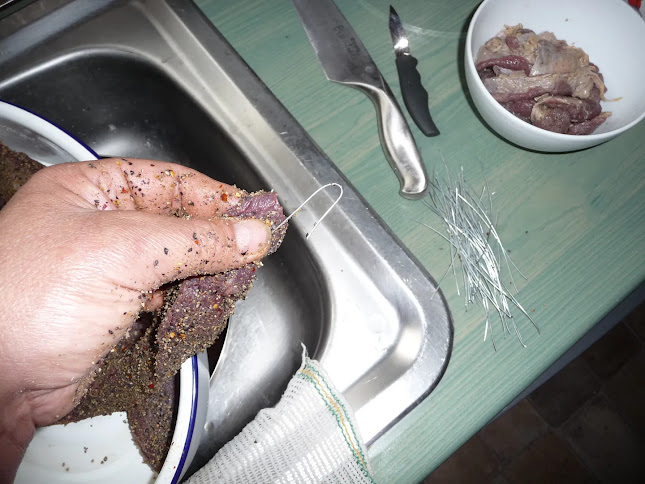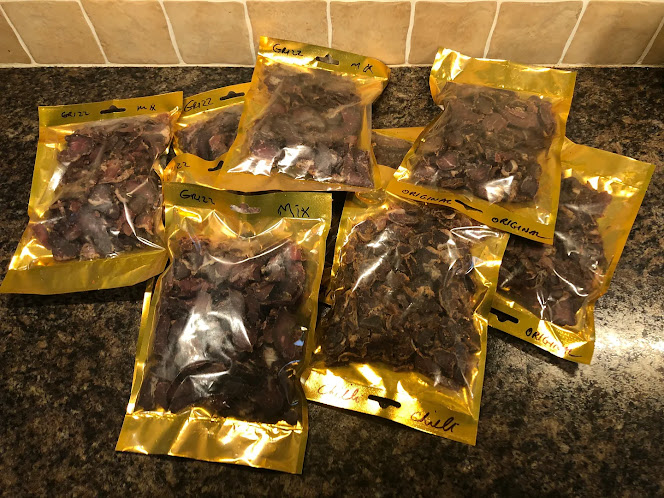This is another space filler while Covid is being a 📦 and slowing me right down and stopping me playing in my workshop.
For many expatriates various things can weigh heavily on their minds.
Family back home ( I had some) , the weather where you came from (Africa is hot) , familiar sounds (gunshots, murder, police sirens, the wind in the woods and more) familiar smells (forest fires, food cooking, Braai Or BBQ for the uninformed) textures ( freshly cut grass underfoot or golden sand between your toes) and all of this is made stronger by it being removed or unattainable in one or another form in your new country.
Growing up in South Africa/Africa, Beef Biltong (not quite Beef Jerky like in America) is one of many presentations of preserving various types of meat, and fish. Game is seen as more luxurious, expensive and coveted, fish, chicken and other types of meat are often seen as exotic or even a “no go” area. For me, anything is acceptable as long as it does not taste crap. So, while I would rather eat Kudu or Ostrich biltong, they are pretty much only accessible over here in England if you stick your fingers deeper in your wallet than the current 2023 beef biltong price around £35.00 to £55.00 per kilogram for beef biltong. And this blog entry is just about making up a drying box, well two different types and making basic biltong.
DISCLAIMER: I am neither a butcher, nor a pro. Everything I share here was done by me, for me, for my pleasure. I make stuff, including recipes, tools and techniques up as I go, using the long lost skill of common sense.
So back in 2002 when I moved to England, one of the things I realised I would be paying a premium for, was Biltong and Droëwors (a dried beef sausage)
Defined by Wikipedia
Droëwors is a popular South African snack food, based on the traditional, coriander-seed spiced boerewors sausage. It is usually made from dun wors (Afr. "thin sausage") rather than dik wors ("thick sausage"), as the thinner sausage dries more quickly and is thus less likely to spoil before it can be preserved. If dikwors is to be used, it is usually flattened to provide a larger surface area for drying.
The recipe used for these dried sausages is similar to that for boerewors, though pork and veal are usually replaced by beef, as the former can go rancid when dried, mutton fat replaces the pork fat used in boerewors. Drying makes the sausage ideal for unrefrigerated storage.
Droëwors is unusual among dried meats in being dried quickly in warm, dry conditions, unlike traditional Italian cured salumi, which are dried slowly in relatively cold and humid conditions. A further difference is that droëwors does not contain curing agent as found in a traditional cured sausage. A direct result of this is that droëwors should not be kept in moist conditions as mold can begin to form more easily than would happen with a cured sausage.
This product is related both in name and in nature to the Dutch droge worst.
I know that making the dried sausage take a bit more effort and resources, needing minced beef, mixing, spicing to flavour and then finding catgut to stuff, plus the stuffing process, followed by drying. So I chose never to make my own wors as it can be bought at a price commensurate with its value to me.
Biltong on the other hand, I was going to give a go, and did so successfully many times in my garage to the amusement and amazement of may friends who thought it was all alchemy and magic. Which it is not.
In 2010 I had gotten married to an English girl who hated biltong and never developed an exotic palate (more for me I hear you say) But she never interfered in any of the crazy stunts I got involved, choosing to motivate and encourage stuff like buying an R1200GS BMW, building the Braai, buying and riding a trials motorbike, my 1966 C10 Chevy truck and a multitude of other sins. She was great as a partner in crime, but has long since moved on to husband no 4 or no 5 not sure if she counts or cares. It was a great time for us both, and no regrets. One of the things we used to do through summer was visit bootfairs (like a fleamarket in a farmers field, where anything and everything was sold, it included a mobile butcher who sold various meats and cuts in a hugely entertaining way. I had started to talk to him and he agreed to bring me complete silverside and top rump sides of beef to use for making my own biltong.
This was his truck, and they would sell from the side, adding various cuts to a tray for £5.00, £10.00, £20.00 and more. You certainly got value for money and entertained at the same time.
So on a Sunday I would come home with a load of beef and proceed to process it, removing the sinew that may sheath the muscle, cutting it all into strips the way I wanted it to be.
You need to mix your spices according to taste and I created my own “Grizz-Mix” which included garlic pepper, ground coriander, ground chillis, pepper and a few other spices
Once the meat is cut to size, it is laid in a bowl/tray on top of coarse salt traditionally, I used cheap fine, table salt, as it was bout 50p per kilo or something like that, and to me the fine salt covered more surface area. The salt primarily is left there for up to an hour (methods do vary) in which time it tends to draw a lot of moisture from the meat. After this, I used a few litres of brown vinegar to wash the salt off the strips of meat, one at a time, laying them out on a clean cloth to absorb more of the liquid and vinegar.
Once covered it was time for the pre-prepared drying hooks. Initially I would make them from thing, disposable wire, but later I made up sharpened hooks that were washed and dried between batches.
My first drying cabinet at the new house in 2010-ish was a used kitchen cabinet, doors de-hinged and screwed up to open differently, I also created a false floor with two lightbulbs in the floor to create the slow, rising heat needed to heat the air, in order to create a draught to effectively draw the moisture off the strips that were hung off rails inside the sealed cabinet, escaping out some vents in the top edge. I hope that makes sense.
After 4-5 days I am usually in there, trying the thin tips, or even some purpose made scraps to see if the flavour meets my standards, not that I am much of a judge of character or quality, it always tasted heavenly to me, especially the initial scraps.
Despite living in the UK, and not having Africa under your feet……
You had Europe at your doorstep.
So many weekends, sometimes just a day, were spent jumping impulsively onto a ferry to Calais and going shopping in France, returning with French cheeses, bread (only good for a day or two, but still great to have) french meat product and fruit. I remember discovering flat peaches in a small fruit market in calais, buying a few and eating them in the street while walking around, then going back and buying a whole bag full to continue snacking on the next few days.
Also available would be Paris, Germany, Belgium, the Netherlands etc, cheap tickets on Eurostar and two hours later you got off in Paris Gare du Nord and took the very efficient underground to central Paris, a short walk to the hotel and be out mingling with tourists by 11.00 on a Saturday or Friday morning.
The food and atmosphere soon had you forget about Biltong and Sunny South African skies.
So in closing, I guess we lose some of our home culture when we relocate to a better/different life.
Not everyone has the balls to take on a new life in a strange country and culture, and it can be tough for various reasons. But little things like making your own produce, products, building, teaching, learning and sharing are all ways to enrich yourself and possibly your host country.
It will never be your home country, but that should not stop you from making it your home.
I have met a few African here, not just from South Africa, but Southern Africa and they all want to make it a better place, wherever they go to in the world and settle, Africa in your blood means working hard for what you want and need, and often the hands dealt seem unfair, biased, nepotistic, but you know that if the effort you put in is more than the average, you have a better than average chance of success.
For my 60th birthday, my buddy Craig, from whose dad I used to buy car spares as a student in Port Elizabeth, sent be a Biltong and droewors “cake” made up and supplied by Mark linked below to his Facebook marketplace shop.
Situated in Shropshire, Mark will package and post your biltong anywhere you specify, at your cost. Postage or couriers are a fixed tariff.
http://www.markstastytong.com/
Original detailed Biltong making here: https://forum.retro-rides.org/thread/106492/carnivores-congregate-biltong-seasons-chilli
LIFE IS GOOD.
Thanks for reading and sharing.
































Hi Rian, you owe me a new keyboard.........when i saw those lekker vet biltong man o man!!
ReplyDeleteVery nice matey.
Rian,
ReplyDeleteGreat story about an African specialty most people will never have the opportuntiy to try.
Always enjoy your posts; you have a great knack for story-telling.
Scott